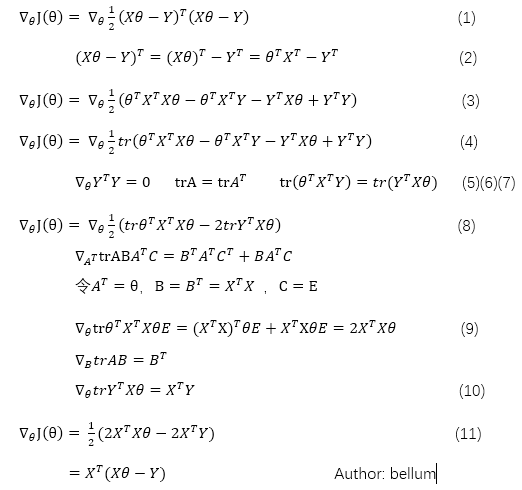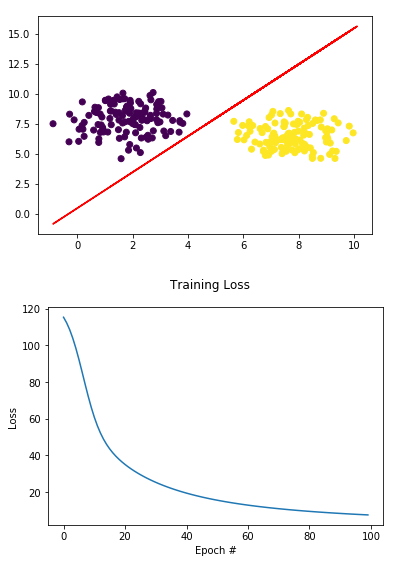梯度下降算法推导与Python实现
在求解机器学习算法的模型参数,即无约束优化问题时,梯度下降(Gradient Descent)是最常采用的方法之一,另一种常用的方法是最小二乘法。这里就对梯度下降法做一个完整的总结。
1. 梯度下降法的具体描述,请点击链接:刘建平Pinard梯度下降(Gradient Descent)小结。 他已经将梯度下降的方方面面都讲得很详细了。
2. 本文补充两点:
①梯度下降的算法(矩阵式)推演
②梯度下降算法的Python实现
2.1 梯度下降算法推演

(1)式为当前位置所要求的梯度函数,(2)式将其展开生成(3)式,(4)式根据迹的特质,实数的迹等于其本身。(5)(6)(7)进行简化得到(8)式,根据公式产生式(9)(10),带入(8)式,生成(11)式,得出梯度。
2.2 Python实现
1 import matplotlib.pyplot as plt 2 from sklearn.datasets.samples_generator import make_blobs 3 import numpy as np 4 5 #这里用的案例是逻辑回归分类 6 def sigmoid(x): 7 return 1.0/(1+np.exp(-x)) 8 9 (X, y) = make_blobs(n_samples=250, n_features=2, centers=2, 10 cluster_std=1.05, random_state=20) 11 12 #为所有的theta0,添加一个值为1的变量X0 13 X = np.c_[np.ones((X.shape[0])), X] 14 15 #初始化权重theta,这里是w 16 W = np.random.uniform(size=(X.shape[1],)) 17 18 lossHistory = [] 19 a = -0.01 #步长 20 21 for i in np.arange(1,100): 22 preds = sigmoid(X.dot(w)) 23 error = preds - y 24 loss = np.sum(error ** 2) 25 lossHistory.append(loss) 26 print("[INFO] epoch #{}, loss={:.7f}".format(epoch + 1, loss)) 27 gradient = X.T.dot(error) / X.shape[0] 28 W += a * gradient 29 30 for i in np.random.choice(250, 10): 31 activation = sigmoid_activation(X[i].dot(W)) 32 label = 0 if activation < 0.5 else 1 33 print("activation={:.4f}; predicted_label={}, true_label={}".format( 34 activation, label, y[i])) 35 36 plt.figure() 37 plt.scatter(X[:, 1], X[:, 2], marker="o", c=y) 38 plt.plot(X, Y, "r-") 39 40 # construct a figure that plots the loss over time 41 fig = plt.figure() 42 plt.plot(np.arange(0, 100), lossHistory) 43 fig.suptitle("Training Loss") 44 plt.xlabel("Epoch #") 45 plt.ylabel("Loss") 46 plt.show()
最后生成图像

【参考资料】
1. 刘建平Pinard梯度下降(Gradient Descent)小结
2. 梯度下降法数学推导
3. Gradient Descent with Python
4. 简单多元线性回归



